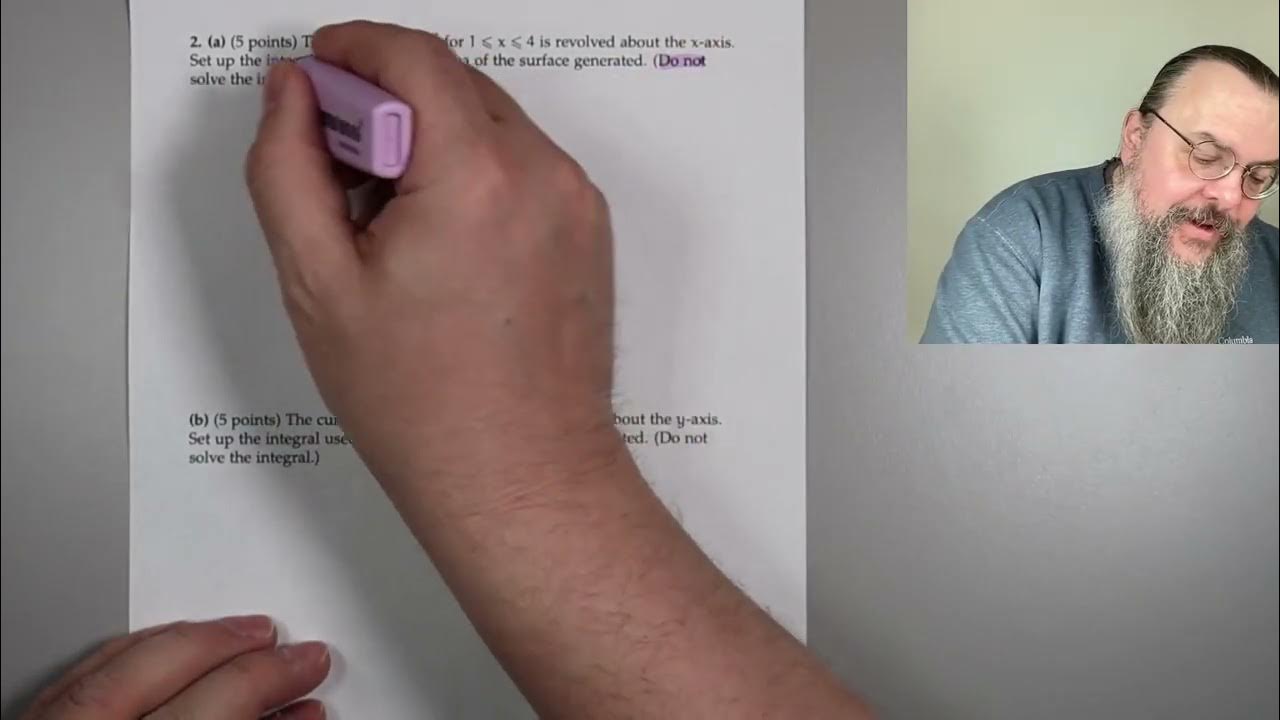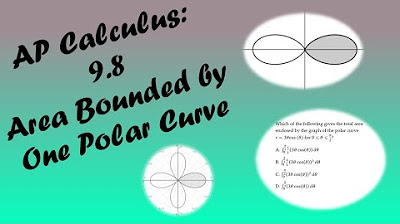More on Polar Graphs
TLDRThis educational video concludes the year's series on DC calculus by tackling a complex free response question that blends polar and parametric equations. The instructor guides viewers through sketching a polar curve, calculating the area under the curve, determining the angle corresponding to a specific x-coordinate, and finding derivatives to analyze the curve's behavior. The video also explores the implications of these calculations, such as the curve's movement towards the origin and the direction of a particle traveling along the curve, providing a comprehensive understanding of polar and parametric concepts.
Takeaways
- 📚 The video is the last one of the year for DC Calculus, focusing on a free response question involving polar and parametric equations.
- 📈 The curve is described in polar coordinates with R = 2 + sin(2θ), where θ ranges from 0 to π and R is measured in meters.
- 📊 The graph of the curve is sketched using polar mode, showing a unique shape that resembles a character named Gary from SpongeBob.
- 🔍 The area bounded by the curve and the x-axis is calculated using the integral of \( \frac{1}{2} \int_{0}^{\pi} R^2 d\Theta \), resulting in an area of 7.69 square meters.
- 📍 To find the angle θ corresponding to the point on the curve with an x-coordinate of -1, conversion equations from polar to rectangular coordinates are used.
- 🧮 The value of θ when x = -1 is found to be approximately 2.63036 radians, or 150.688 degrees.
- 📉 The derivative \( \frac{dR}{d\Theta} \) is calculated to determine how R changes with respect to θ, showing that R decreases as θ increases.
- 🔢 At θ = 5π/7, the derivative \( \frac{dR}{d\Theta} \) is found to be -0.445, indicating that R is decreasing at that point.
- 🚀 The video also discusses a particle traveling along the curve with a constant rate of change in θ, given by \( \frac{d\Theta}{dt} = 3 \).
- 🌐 The derivative \( \frac{dx}{dt} \) is calculated when θ = π/6, revealing a negative value, which means the x-coordinate is decreasing as the particle moves along the curve.
Q & A
What is the main topic of the video?
-The main topic of the video is to analyze a free response question that combines polar and parametric equations in the context of calculus.
What is the given polar equation for the curve?
-The given polar equation for the curve is R = 2 + sin(2θ).
What is the domain of the Theta variable in the polar equation?
-The domain of the Theta variable is from 0 to π radians.
How does the curve look like when Theta is 0 or π/2?
-When Theta is 0 or π/2, the value of R is 2, which means the curve touches the x-axis at these points.
What is the area bounded by the curve and the x-axis?
-The area bounded by the curve and the x-axis is calculated to be approximately 7.69 square meters.
What is the x-coordinate of the point on the curve where Theta corresponds to an angle greater than π/2 but less than π?
-The x-coordinate of the point on the curve at this angle is -1.
How can you convert polar coordinates to rectangular coordinates to find the x-coordinate?
-You can convert polar coordinates to rectangular coordinates using the equation X = R * cos(θ).
What is the value of the derivative dR/dθ at the point where Theta equals 5π/7?
-The value of the derivative dR/dθ at Theta equals 5π/7 is approximately -0.445.
What does a negative derivative dR/dθ indicate about the curve?
-A negative derivative dR/dθ indicates that the curve is getting closer to the origin or the pole, meaning the radial lines are decreasing.
What is the problem with finding the value of dx/dθ when Theta equals π/6?
-The problem requires finding the derivative of x with respect to Theta when Theta equals π/6, given that dθ/dt is 3.
What does the negative value of dx/dt when Theta equals π/6 signify?
-A negative value of dx/dt signifies that the x-coordinate is decreasing, meaning the particle is moving to the left along the curve at that point.
Outlines
📚 Introduction to Polar and Parametric Equations
The video begins with an introduction to a mixed problem involving polar and parametric equations, set to be the final video of the year for DC Calculus. The instructor aims to analyze a free response question that combines these two mathematical concepts. A curve is presented in the XY plane with given polar coordinates and a domain for Theta from 0 to Pi. The task is to sketch the graph using polar coordinates, where R equals 2 plus the sine of 2 Theta. The instructor demonstrates how the graph appears at different Theta values and humorously compares the shape to a character named Gary from SpongeBob. The area enclosed by the curve and the x-axis is then calculated using the integral of R squared with respect to Theta, resulting in an area of 7.69 square meters.
🔍 Finding Specific Angles and Derivatives
The second paragraph delves into more detailed analysis, starting with finding the angle Theta that corresponds to a point on the curve with an x-coordinate of -1. The instructor explains the conversion from polar to rectangular coordinates using the equation X = R * cos(Theta) and demonstrates solving for Theta when X equals -1, yielding a result of approximately 150.688 degrees. Moving on, the instructor calculates the derivative of R with respect to Theta (dR/dTheta) to understand how R changes as Theta varies. A negative derivative indicates that R is decreasing, suggesting the curve is being pulled towards the origin. The paragraph concludes with an exploration of a particle's motion along the curve, given by parametric equations X(T) and Y(T), with a constant rate of change for Theta. The instructor finds the value of dx/dt when Theta equals pi/6, interpreting the negative result as the x-coordinate decreasing, indicating the particle is moving to the left along the curve at a rate of -1.7096 meters per unit radiant.
Mindmap
Keywords
💡Polar Coordinates
💡Parametric Equations
💡Integral
💡Theta (θ)
💡Derivative
💡Area
💡Radians
💡Sine Function
💡Cosine Function
💡Chain Rule
💡Graph
Highlights
Introduction to a free response question that combines polar and parametric equations.
Explanation of how to sketch the graph of a curve given in polar coordinates.
Guidance on using Polar mode to input the equation R = 2 + sin(2θ).
Description of the graph's appearance at different values of Theta.
Calculation of the area bounded by the curve and the x-axis using integration.
Use of the integral formula and the given equation to find the area.
Result of the area calculation as 7.69 square meters.
Finding the angle Theta for a specific x-coordinate on the curve.
Conversion from polar to rectangular coordinates using the equation X = R * cos(Theta).
Graphical method to find the angle using function mode and intersection calculation.
Result of Theta being approximately 150.688 degrees for x = -1.
Derivative of R with respect to Theta to find the rate of change of the curve.
Calculation of the derivative at a specific Theta value using the chain rule.
Interpretation of a negative derivative indicating the curve is moving towards the origin.
Particle's motion along the curve with a constant rate of change in Theta.
Finding the value of dx/dt and its interpretation when Theta equals pi/6.
Result of dx/dt being negative, indicating the x-coordinate is decreasing.
Conclusion of the video with a summary of the findings and a sign-off.
Transcripts
Browse More Related Video

Polar, Parametric, Vector Multiple Choice Practice for Calc BC (Part 4)

Polar, Parametric, Vector Multiple Choice Practice for Calc BC (Part 1)

Polar, Parametric, Vector Multiple Choice Practice for Calc BC (Part 2)

2 | FRQ (Calculator Active) | Practice Sessions | AP Calculus BC

Calc 2, Exam 1 walkthrough (Fall 2023)

AP Calculus BC Lesson 9.8
5.0 / 5 (0 votes)
Thanks for rating: